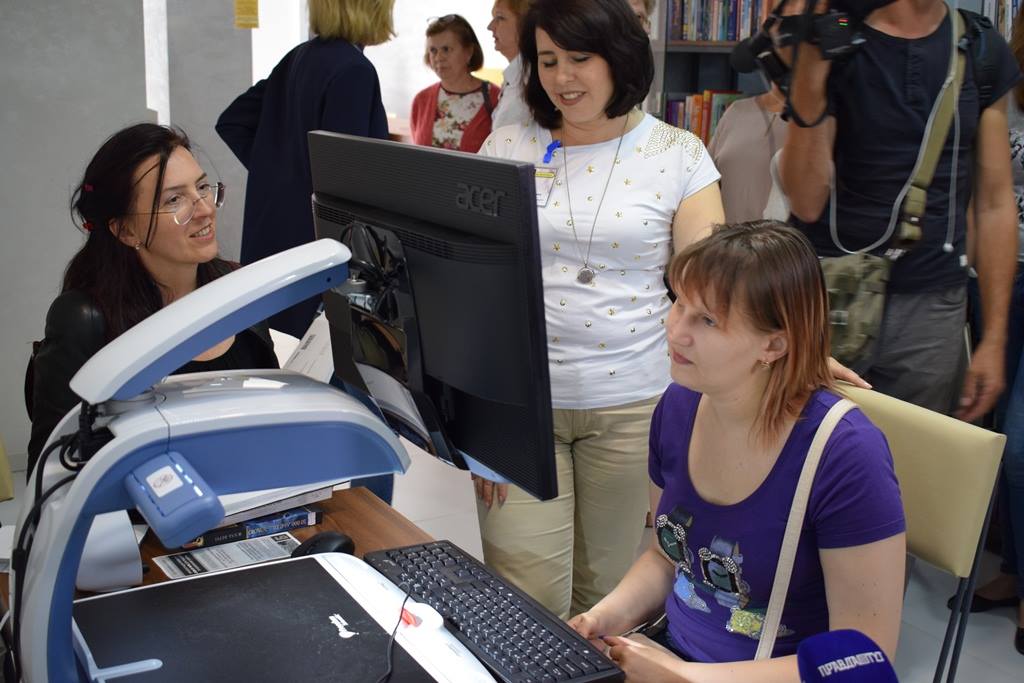Ukraine adopting EU standards in website design to make websites more accessible
New standard to change government websites and applications
October 17, 2022

Daria Korzhavina (right, sitting at computer) tests out a website adapted for the visually impaired.
Originally published at NV website on 15 October 2022
Daria Korzhavina is an active young woman. She is a journalist, civic and political activist, co-founder of the Fight for Right NGO, human rights activist, winner of the Top 30 Under 30 award, and a mother of a seven-year-old daughter. She constantly uses websites and social networks, and reads and writes a lot on the Internet.
She is also blind.
A screen reader helps her work online. This is a software application that renders text and image content as speech, and many mobile phones also have this software. Mobile applications operate on the following principle: when the user taps an application, they announce the name of the application; quickly double tapping the application opens it.
But these functions don’t always help, due to poor design of websites.
“Only yesterday, I wanted to sign a petition on a government website, and I couldn’t do it,” Korzhavina says. “That was because using a screen reader I couldn’t choose a way to access the site and enter my login details. This upset me, to be very honest.”
It is quite convenient to read government websites using a screen reader, she says of her experience. The problems usually arise when you want to do something more complex – for example, if you want to choose a service or find your city or district in a drop-down list.
“When you’re looking for services or goods, such lists are usually the biggest problem,” she says.
In the past, before speech generating devices became widespread, people with visual impairments had to remember how many times to press a key to perform a particular action on a mobile phone. Press down three times, right four times, then press ‘OK’. This is often the case with websites today, she says.
“It’s 2022, the 21st century, screen readers are everywhere, and you’d expect websites to be adapted, but you have to remember how many times you need to hit cursor control keys to select a search filter on a website,” Korzhavina says with a smile.
Why are some websites inaccessible?
Lists are far from being the only problem faced by people who use resources that have not been made sufficiently accessible by their developers. Being unable to read a text on a mobile phone in bright sunlight is one such example.
Poor contrast, small fonts, no subtitles for videos, no alternative text for images and text descriptions of icons, incorrectly marked headings or tables – this is just the tip of the iceberg, says Dmytro Popov, a web accessibility consultant of the United Nations Development Programme (UNDP), commenting on common problems with websites. He has been working in the field of web accessibility for over 10 years, giving advice to a host of government bodies and international organizations.
Screen reader users have problems when website developers fail to observe the basic principles of web accessibility. Often this is due to a lack of awareness, he explains.
“Many people, even website developers, are very surprised when they hear that people with disabilities use websites, order goods, products and tickets online, or even submit reports as sole proprietors via Diia,” says Popov. “They simply can’t imagine that blind people can use a computer.”
Therefore, when creating products, developers are not thinking about how these products would be used with a screen reader. For example, they test a newly created website only with a computer mouse, while screen reader users usually use a keyboard. They also provide no alternative text for images, despite the fact that without them a screen reader cannot describe these images – it’ll just say they’re there.

Web accessibility expert Dmytro Popov explains basics of web-accessibility during a UNDP-supported training session for public servants in Osvitoria, Kyiv, in October 2021.
However, web accessibility concerns not only people with disabilities, Popov says, as these people account for only 10-15% of all website users. Up to 50% of all of a website’s viewers are users with limited mobility: a person who can hear, but cannot turn on the sound in a video because a child is sleeping nearby; a person with an injured hand or whose hands are busy, holding bags in one hand and trying to order a taxi with the other; or a person who can see, but poorly.
Most of the requirements that meet the needs of such users are set in the Web Content Accessibility Guidelines (WCAGs). These guidelines provide a detailed description of how web content can be made accessible to the greatest possible number of people.
A lack of awareness – and standards
In the case of government websites, accessibility is critically important. While in the commercial sector a person can close an inaccessible website and use another one, there are simply no alternatives for government products, says Popov.
That said, for a long time Ukraine ignored the problem of web accessibility. A state standard, DSTU (Ukrainian State Standard) regulating web accessibility was adopted only in 2016 in Ukraine, and it became mandatory for executive authorities only in 2019. Until then, there was no relevant legislation in the country.
“We thought: what do people with disabilities need websites for?” says Popov, explaining the situation with web accessibility. “When a blind person or a person with reduced mobility asked website owners to fix things, they weren’t taken seriously. As if they were just being fussy.”
At the same time, no Ukrainian translation was provided for WCAG 2.0, which underlay the national standard. As a result, the guidelines were not fully accessible to developers.
However, in recent years the situation has gradually become on a par with Western countries, says Popov.
In 2021, at the request of the United Nations Development Program in Ukraine (UNDP), he, together with other experts, tested 82 government websites that provide services online. Later, they tested another 100 of the executive authorities’ websites. He also analysed how the accessibility of government authorities’ mobile apps is regulated in other countries.
At that time, the results showed that government websites in Ukraine are not 100% accessible. And one of the recommendations made by the compilers was to adopt the European EN 301 549 – a leading accessibility standard – as a new state standard in Ukraine.
What will change now?
Work is underway to incorporate the recommendations – the Ministry of Digital Transformation of Ukraine, supported by UNDP, has set up a new web accessibility standard. The standard came into force on 15 June.
The new Ukrainian standard (DSTU EN 301 549:2022 “Information technology. Requirements for the Accessibility of ICT Products and Services”) completely duplicates the eponymous European standard. It is based on a newer version of WCAG 2.1, which has been used by European legislators for several years.
These guidelines contain several new criteria that developers are required to meet in order to make their products accessible, says Popov, who helped review the Ukrainian translation of the European standard. A translation into Ukrainian of the standard, createdin partnership with the World Wide Web Consortium (W3C) was also provided to make it easier for developers to use it.
The main difference, however, is that the new state standard contains requirements for mobile applications and electronic documents – the previous version was only applicable to websites.
“This is a big breakthrough, because now digitalization in Ukraine is based on the mobile-first approach,” says Dmytro.
“This means that usually all important services are provided first in mobile applications. These are local applications – such as Kyiv Digital, Diia – which provides all state services, and the applications of Ukraine’s National Police.”
The Ministry of Digital Transformation, together with UNDP experts, also drew up a resolution that will require executive authorities at all levels to comply with the standard. The resolution is currently under consideration by the Cabinet of Ministers of Ukraine.
After its adoption, all new government web resources in Ukraine – both websites and mobile applications – will be created in accordance with the new requirements. A transitional period will be established to change and adapt existing applications and websites. However, making changes to web resources will not take much time, Popov thinks.
“Bringing a website into line with accessibility requirements is not as difficult as it seems,” he says.
“Accessibility usually does not require any special actions. Often all that you have to do is to provide text descriptions for buttons and to make the text more contrasting. This doesn’t usually take a lot of time, or cost a lot of money.”
However, he recommends meeting accessibility requirements when developing a web resource in the first place: it is the easiest and cheapest way to do it.
Greater accessibility, more users
When government websites and mobile applications become accessible, people will use them more actively, says Korzhavina.
“Currently there are many state projects in which you can participate, for example, submit or vote for a participatory budgeting project in your city,” she says. “If this service is accessible to more people, more people will come, and people’s engagement will increase.”
After all, many people with disabilities want to be active, but they don’t always have the opportunity to do this activity, she adds.
It goes without saying that government websites should be accessible – all people, including people with disabilities, pay taxes, so government websites should be accessible to them, Popov says. After all, providing accessibility is primarily about ensuring people’s rights, say Popov and Korzhavina, earnestly.
“You come into a pharmacy, ask, ‘Why do you have no ramp?’, and hear in response: ‘Well, people in wheelchairs don’t go to our pharmacy.’ Yes, maybe they don’t go to your pharmacy because you have no ramp?” Korzhavina says in exasperation.
The same is true of web accessibility, she continues. People will not waste their time on an inaccessible website. “It’s like a vicious circle – no accessibility, no people. And there won’t be any if there is no accessibility.”
Therefore, the benefits for commercial websites are obvious: the greater the accessibility of a website, the greater number of people will be able to use it, and the greater the profit that the owner makes.
Websites often have separate versions for people with visual impairments. Korzhavina says that she has never used them. “I don’t think there’s a need to make a separate version. Can you make a website that all people (including those with impaired vision, hearing, or motor skills) can go to and use just like all other users, without having to follow a special link?” she asks.
After all, in times of war, web accessibility has become important for us as never before, says Korzhavina. “Many soldiers have lost their eyesight in battles,” says Korzhavina.
“It’s unthinkable that these days people can be cut off from information and be unable to use the Internet like they did before. It’s like you’re missing out on life. And we have no right to deprive those people who have saved our lives of their online lives.”
This material was prepared by UNDP in Ukraine to mark International White Cane Day, which is celebrated worldwide on Oct. 15. Established to raise public awareness about people who use a white cane, this official UN international day now draws attention to the rights of the visually impaired in general.

 Locations
Locations